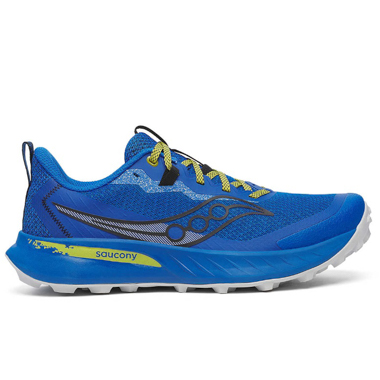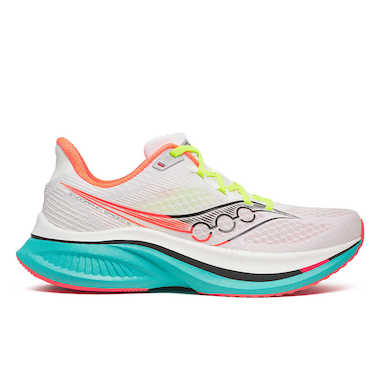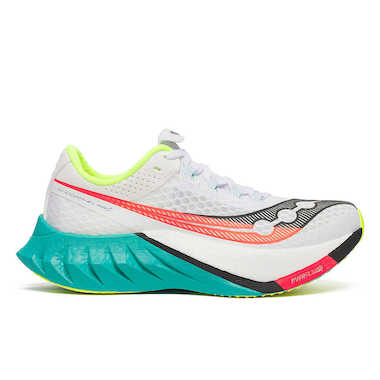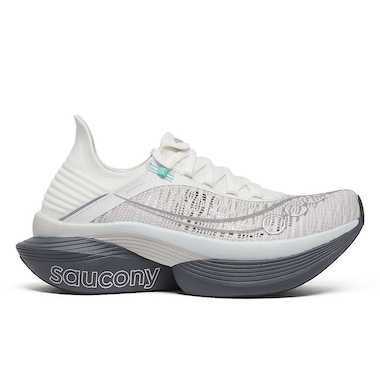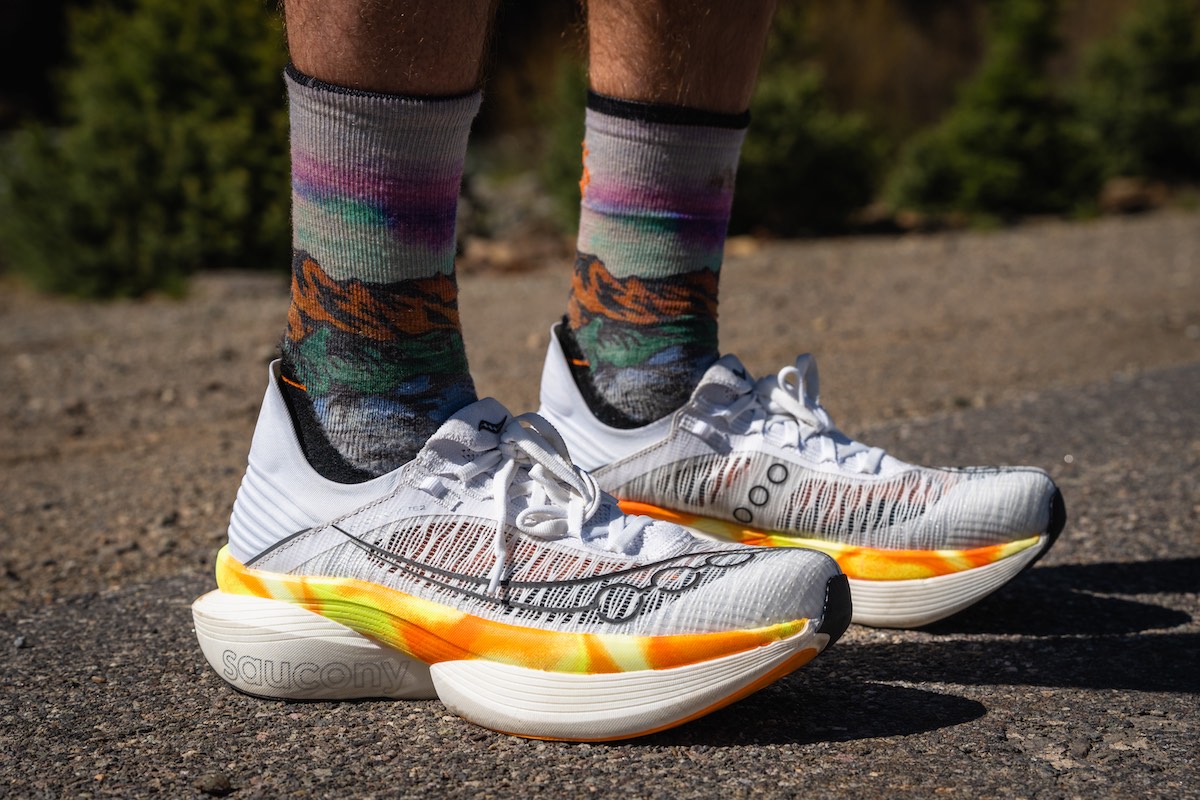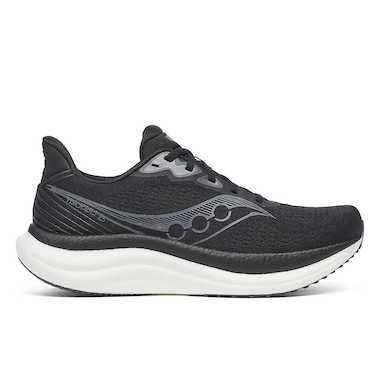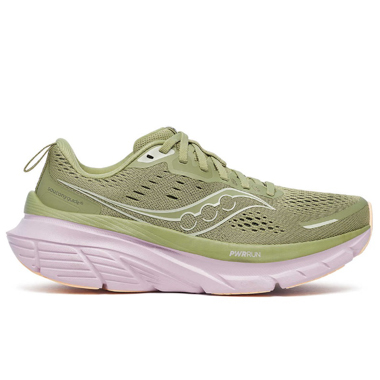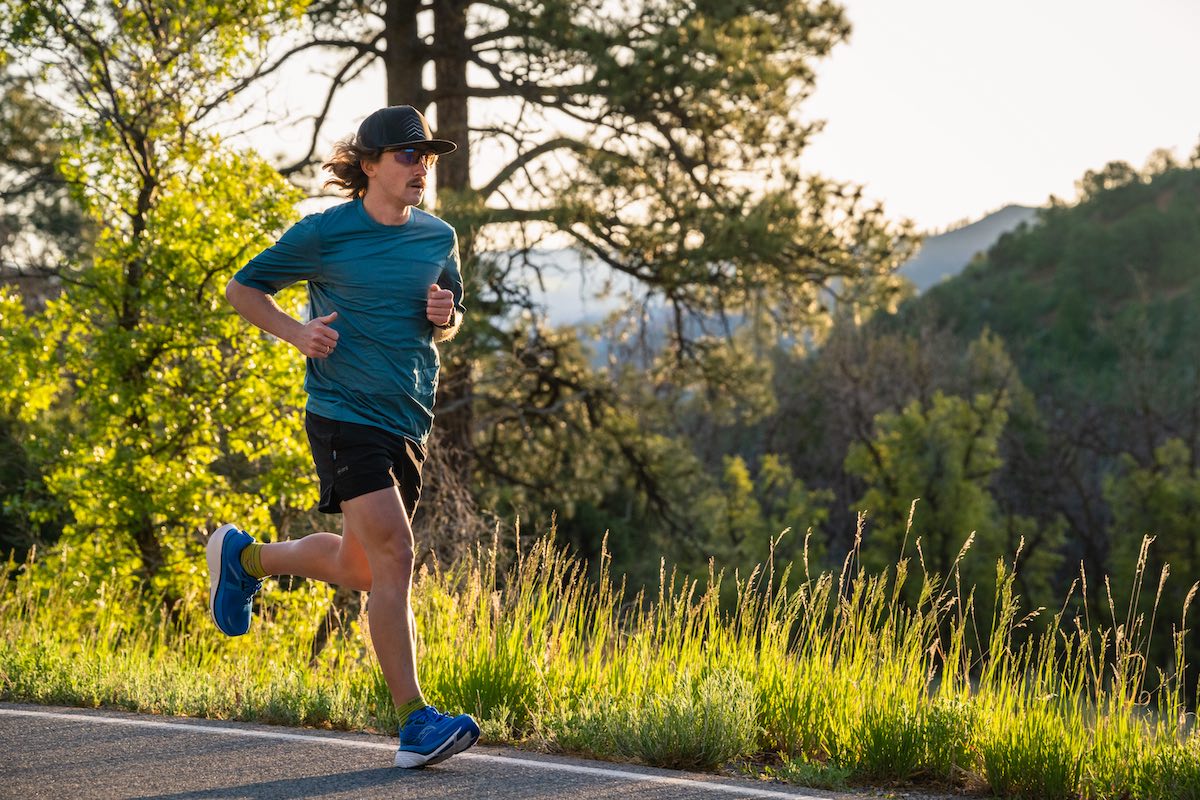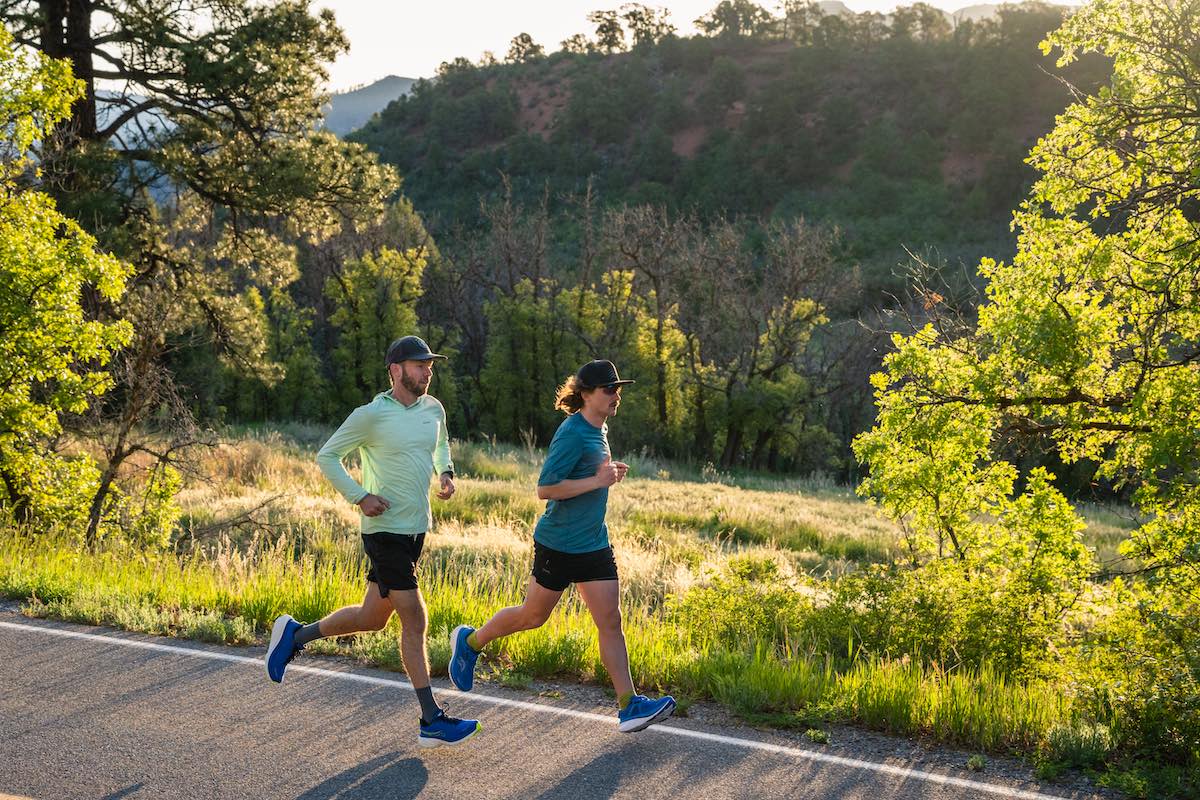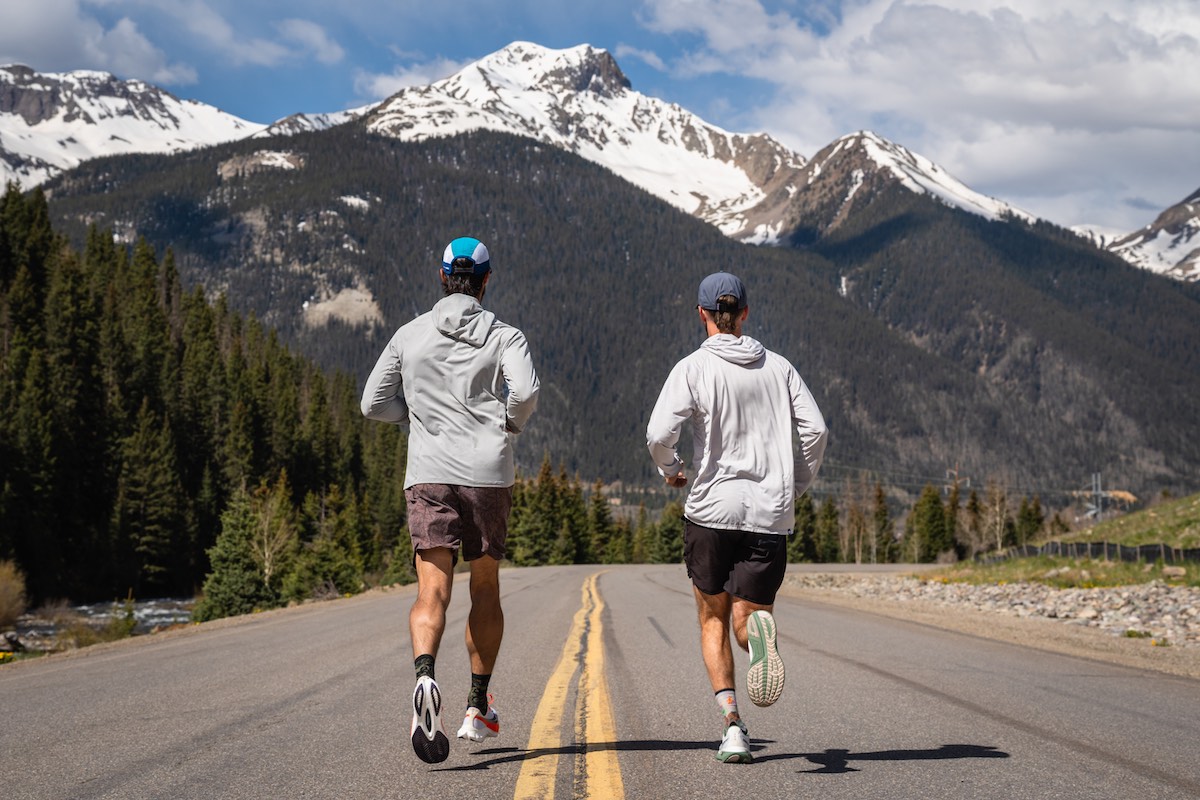
Saucony has been making quality running shoes longer than nearly any other brand out there. Photo: iRunFar/Eszter Horanyi
Saucony is one of the oldest athletic footwear companies in America. Launched in Pennsylvania in 1898, the brand was well-positioned to capitalize on the American jogging boom in the 1970s and 1980s. Nowadays, Saucony is still one of the best all-around running shoe brands. Despite pushes from younger brands like Hoka, On, and Topo, Saucony remains a favorite shoe brand for many runners.
We’ve run in Saucony shoes for decades and collectively logged thousands of miles in the various models. Below, we outline six of the best Saucony shoes currently available. Our pick for the best overall trail running shoe is the classic Saucony Peregrine 15, which continues to hold its place in our Best Trail Running Shoes guide thanks to its ability to meet the needs of most off-road runners. There Peregrine is Saucony’s flagship trail shoe, and besides the Xodus Ultra 4, which we’re currently testing, is basically the brand’s only trail shoe. Saucony, does have plenty of road options, though. Similar to the Peregrine, the Saucony Endorphin Speed 5 is our pick for the best road running shoe for its versatility. It’ll suit most runners for easy runs, strenuous workouts, and even races.
Want to learn more about our testing and methodology, how to choose a Saucony running shoe, or our answers to frequently asked questions? Read on.
The Best Saucony Running Shoes
- Best Overall Trail Running Shoe: Saucony Peregrine 15
- Best Overall Road Running Shoe: Saucony Endorphin Speed 5
- Best Road Racing Shoe: Saucony Endorphin Pro 4
- Best Road Racing Shoe — Runner-Up: Saucony Endorphin Elite 2
- Best Maximum Cushion Road Shoe: Saucony Triumph 23
- Best Stability Road Shoe: Saucony Guide 18
Best Overall Trail Running Shoe: Saucony Peregrine 15 ($140)
- Good mid-range lug depth and drop
- Comfortable
- Improved durability
Cons:
- It’s not quite a racing shoe
- Not great in wet and sloppy conditions
The latest in a line of shoes that people have loved for over a decade, the Saucony Peregrine 15 doesn’t stray far from its lineage. It’s a classic for a reason. This do-everything option has impressed us so much over the years that we continue to feature it in our Best Trail Running Shoe guide. What makes it stand out? Let’s start at the base where Saucony employs its PWRTRAC rubber outsoles with 5-millimeter lugs, which are the perfect size to easily handle dry conditions and have enough depth to perform well in light mud. The outsole struggles in really slippery conditions, like on wet rocks or moss.
Saucony upgraded the midsole of this shoe from the previous version. The new one is a bit less bulgy in appearance than the Peregrine 14 and features a softer, single-density foam. The 28-millimeter heel and 24-millimeter toe stack height keep runners fairly close to the ground, and the 4-millimeter drop is ideal for most runners, as it’s not overly aggressive nor in the zero-drop range. Finally, the new PWRRUN+ sock liner provides underfoot comfort, and a unique lacing system helps lock down the feet.
This incredibly versatile shoe can handle normal training runs, up-tempo workouts, long runs, or races. We took the shoe on steep and technical trails, flat dirt, and crushed gravel paths, and it performed. But perhaps our favorite thing about this shoe is its durability. We put more than 400 miles on previous versions of this shoe and definitely could’ve added more. With more than 100 miles on this version, we haven’t noticed the midsole packing out or significant damage to the upper, even after using them in wet and muddy conditions in the Pacific Northwest winter.
Of all the shoes in this guide, the iRunFar team has the most miles on the Peregrine models. Over the years, Saucony has continued to incrementally improve the shoe, making it one of the best all-around off-road shoes available. The brand offers this shoe in wide and waterproof versions. Look no further if you’re searching for an everyday trainer to take on the trails.
To learn more, check out our in-depth Saucony Peregrine 15 review.
Actual Weight (U.S. men’s 9): 9.7 ounces (273 grams) | Stack Height: 28/24 millimeters heel/toe | Drop: 4 millimeters | Support: Neutral
Shop the Men's Saucony Peregrine 15Shop the Women's Saucony Peregrine 15
Best Overall Road Running Shoe: Saucony Endorphin Speed 5 ($175)
- Good for training, speedwork, and race day
- Incredibly comfortable and lightweight
Cons:
- It’s hard to take easy days easy
At iRunFar, we like versatile shoes that can do it all, and that’s what you get with the Saucony Endorphin Speed 5. While Saucony designed this shoe for racing, it also works well as an everyday trainer. It can serve as a long-run, tempo, or race-day shoe for distances up to a marathon. With a winged nylon plate that acts similarly to a carbon plate to provide a high level of energy return at a fraction of the cost, this shoe is highly responsive and relatively affordable for a race shoe.
The 36-millimeter stack height at the heel and 28-millimeter stack height at the toe are fairly high and provide plenty of cushion that makes for a comfortable ride. Saucony’s proprietary PWRRUN PB midsole foam is lightweight and responsive, so you get all the cushion without the weight and clunky feel. The brand’s Speedroll technology, when combined with the responsive foam, provides a responsive, fun ride that left us smiling. Our main tester and her friend, who also used these as road trainers over the past winter, have dorsiflexion and both said the Speedroll technology and rocker helped serve as a crutch while training.
We found the 8-millimeter drop to be just about right for forward propulsion. The latest version of the shoe has a few minor updates. The upper includes new lightweight mesh, and the outsole has added protection at the heel to increase durability. We really didn’t notice much of a difference between the fourth and fifth iterations of this shoe. With a claimed weight of 8.3 ounces for the men’s version and 7.3 ounces for the women’s, the shoe is definitely on the lighter side. While we used these shoes for some easy days, their design, construction, and weight make it a bit too easy to get plenty of giddy-up in your step.
This shoe quickly became our favorite road running shoe this past winter. We took it on easier runs, tempo workouts, and long runs, and it performed well on each. If you’re looking for a shoe to ensure you take your easy days easy, check out the Triumph 23 or Guide 18 below. But, if you’re looking for a do-it-all shoe that blurs the lines between everyday training, speed workouts, and racing, you’d be hard-pressed to find a better option than the Endorphin Speed 5.
Claimed Weight (U.S. men’s 9): 8.3 ounces (237 grams) | Stack Height: 36/28 millimeters heel/toe | Drop: 8 millimeters | Support: Neutral
Shop the Men's Saucony Endorphin Speed 5Shop the Women's Saucony Endorphin Speed 5
Best Road Racing Shoe: Saucony Endorphin Pro 4 ($240)
- Approachable and accessible to most runners
- Excellent for speed workouts and races
Cons:
- Not the fastest super shoe
The Saucony Endorphin Pro 4 is one of the brand’s road racing super shoes. While many will probably opt for Saucony’s top-shelf, premier racing shoe — the Endorphin Elite 2 reviewed below — we humbly suggest the Endorphin Pro 4 is better for most runners. Why? It’s more approachable and accessible than the Endorphin Elite 2, which puts runners into a more aggressive stride and stance. You can essentially think of this shoe as a step up from the Endorphin Speed 5, reviewed above. One of our testers trained in the Speed 5 but raced in this shoe when speed really mattered. It is slightly lighter, higher-stacked, and has a bit more premium material than the Speed 5. Other than that, it has a similar feel.
Starting at the bottom, Saucony strategically employs pieces of rubber in the forefoot and heel on top of the midsole foam. It’s a pretty similar outsole construction to the Speed 5, but with a bit more coverage. Moving up the shoe, Saucony uses its PWRRUN PB and PWRRUN HG midsole foams in a dual-density design. That, combined with the full-length carbon plate and Speedroll technology, is what creates such an efficient, fun, and fast shoe. The upper is comfortable, breathable, and has a good fit.
We’ve had a handful of people in our network, including one of our main shoe testers, trying both the Endorphin Pro 4 and Endorphin Elite 2, and opted to put the Pro 4 as our top Saucony road racing shoe simply because they think it’ll be the best racing shoe for the most amount of people. As one tester put it, the Elite 2 can be overly aggressive and too much, although they still believe the Pro 4 takes off 10 to 15 seconds per mile compared to daily trainers. Our one hesitation with the Pro 4 is that the cost is still similar to the higher-end racing shoes like the Endorphin Elite 2, or Nike Alphafly or Vaporfly. However, for most runners, we recommend saving the extra $50 or so and opting for a shoe that won’t feel like too much.
Claimed Weight (U.S. men’s 9): 7.5 ounces (212 grams) | Stack Height: 39.5/31.5 millimeters heel/toe | Drop: 8 millimeters | Support: Neutral
Shop the Men's Saucony Endorphin Pro 4Shop the Women's Saucony Endorphin Pro 4
Best Road Racing Shoe — Runner-Up: Saucony Endorphin Elite 2 ($290)
- Excellent technology to create a responsive and fast ride
- Lightweight and smooth
Cons:
- Expensive
Designed to compete with the top marathon offerings in the super-shoe market, the Saucony Endorphin Elite 2 is a solid option that remains one of our favorites in the growing carbon-plated shoe market. Being a high-end marathon shoe, it comes with all the bells and whistles, and like a classic super shoe, the focus is on energy return and speed.
The major change to the second iteration of this shoe comes in the midsole foam, where Saucony employs its newest Incredirun foam. The foam is a TPEE blend that provides a soft, responsive, and efficient ride. Saucony stacks it at 39.5 millimeters at the heel and 31.5 millimeters at the toe. It’s an aggressive stack height, but the 8-millimeter drop is pretty middle of the road. The slotted carbon plate boosts energy return and provides a smoother ride. This shoe is slightly lighter than the previous version, weighing only 7.0 ounces (199 grams).
Saucony spent four years developing the first version of this shoe, and it paid off. We loved it. It took them another two years to offer this update. Like the first version, this is a very specific shoe for specific occasions: peak road races and key workout sessions leading up to important races. As we noted in the section above about the Endorphin Pro 4, the Endorphin Elite 2 takes an aggressive stance. And despite having the same amount of stack height, the Endorphin Elite 2 feels much more unstable at slower paces. The faster the pace, the more stable and natural this shoe feels, similar to other premium super shoes.
So, who is this shoe for? We see it as a shoe mainly for elite road racers and those competing for podium spots. For the vast majority of road runners, the Endorphin Pro 4 is the better choice.
Claimed Weight (U.S. men’s 9): 7.0 ounces (199 grams) | Stack Height: 39.5/31.5 millimeters heel/toe | Drop: 8 millimeters | Support: Neutral
Shop the Men's Saucony Endorphin Elite 2Shop the Women's Saucony Endorphin Elite 2
Best Road Running Maximal Cushion Shoe: Saucony Triumph 23 ($170)
- Lots of cushion without being heavy
- Very comfortable
Cons:
- Might be too much stack height for some
The Saucony Triumph 23 is an excellent shoe for the easier and recovery runs on the schedule. It is a classic road running shoe in the Saucony line and focuses on comfort and cushion for daily miles, long runs, or just walking around and running errands. As one of our primary testers of this shoe put it, putting them on “feels like you’re getting a great big hug from the softest of Midwest grandmothers.” That feeling comes from Saucony’s highly responsive PWRRUN PB foam, which provides a heel stack height of 37 millimeters and a toe stack height of 27 millimeters.
Another part of that comfort, softness, and plush feeling comes from the new Super-Responsive Sockliner (SRS). The SRS essentially adds another layer of soft foam underfoot. Saucony also redesigned the outsole, focusing on providing a more responsive and fluid ride. The brand did all of this while also dropping the shoe’s weight from 10.1 ounces to 9.2 ounces for a U.S. men’s 9.
The Triumph 23 is a great daily trainer and overall road running shoe. The reason we put the Endorphin Speed 5 as the best overall shoe in this guide is that they are a bit more versatile, and we know not everyone wants a maximum cushioned shoe. As our tester put it, “These are a great choice for runners who value comfort.” When her feet were tired or she was logging active recovery road miles, she reached for these shoes. And when she recently completed a 50-mile trail race, the Triumph were the shoe she chose to take for her shake-out runs before and after the race and for walking around town.
Claimed Weight (U.S. men’s 9): 9.2 ounces (263 grams) | Stack Height: 37/27 millimeters heel/toe | Drop: 10 millimeters | Support: Neutral
Shop the Men's Saucony Triumph 23Shop the Women's Saucony Triumph 23
Best Road Running Stability Shoe: Saucony Guide 18 ($140)
- Higher stack height and lower drop
- Very comfortable
Cons:
- Only provides light stability
The Saucony Guide 18 is the brand’s premier stability shoe. We liked it so much that we included it in our Best Stability Shoes guide. While the Guide 17 got a pretty major overhaul from the 16, including the addition of the brand’s CenterPath Technology, this newest version only got a few incremental improvements.
The shoe has an asymmetric profile with a broad platform and higher sidewalls to guide your stride into a more neutral gait. Thanks to a high stack height of 35 millimeters at the heel and 29 millimeters at the toe, this shoe is one of the more comfortable stability shoes we tested. It has the brand’s PWRRUN midsole, PWRRUN+ sock liner, and a fair bit of rocker to make for a smooth ride with good turnover. It works great as a daily trainer.
The most significant update this shoe received was to the upper, which we felt improved the comfort of the shoe and increased its breathability. The new upper is soft and accommodating for wider feet, and while running in them during the heat of the California summer, we never had issues with our feet overheating. Weighting 9.6 ounces for a U.S. men’s 9, it is perfect as a daily trainer, as it doesn’t feel clunky and can work for light fartleks or tempos.
The traction and design of the outsole were good enough to handle flat dirt and crushed gravel paths.
Overall, this is a light-stability shoe, so it is for runners looking for just a bit of extra support. If you’re looking for a stability shoe with more guidance or if you’re a hard overpronator, this one might not live up to expectations.
Claimed Weight (U.S. men’s 9): 9.6 ounces (272 grams) | Stack Height: 35/29 millimeters heel/toe | Drop: 6 millimeters | Support: Stability
Shop the Men's Saucony Guide 18Shop the Women's Saucony Guide 18
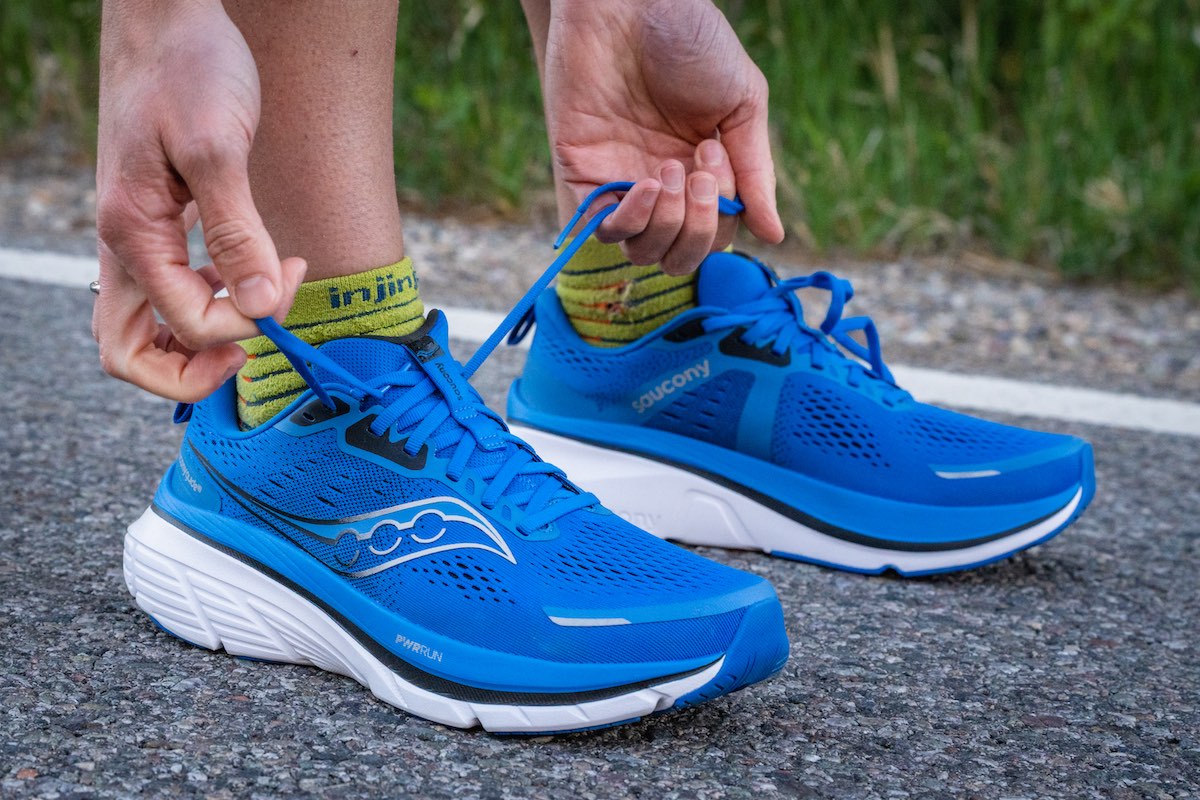
The Saucony Guide 18 is one of the best stability running shoes on the market. Photo by iRunFar/Eszter Horanyi
Comparing the Best Saucony Running Shoes
| SHOE | PRICE | WEIGHT | STACK HEIGHT | USE |
| Saucony Peregrine 15 | $140 | 9.7 ounces | 28/24 millimeters | Trail, every day |
| Saucony Endorphin Speed 5 | $175 | 8.3 ounces | 36/28 millimeters | Every day, speed, race |
| Saucony Endorphin Pro 4 | $240 | 7.5 ounces | 39.5/31.5 millimeters | Speed, racing |
| Saucony Endorphin Elite 2 | $290 | 7.0 ounces | 39.5/31.5 millimeters | Road race, marathon |
| Saucony Triumph 23 | $170 | 9.2 ounces | 37/27 millimeters | Everyday training |
| Saucony Guide 18 | $140 | 9.6 ounces | 35/29 millimeters | Everyday training |
Glossary of Running Shoe Terms
The anatomy of a running shoe can be complicated. We try to avoid jargon in our buyer’s guides, but sometimes it’s inevitable, so we put together a glossary of frequently used terms when describing running shoes.
- Stack Height: This is the amount of space between the bottom of your foot and the bottom of the shoe, measured in millimeters, and includes the midsole foam and outsole. Most shoes have a higher stack height at the heel than the toe, and the shoe’s drop is the difference between those heights. Zero-drop shoes have the same stack height at the heel as the toe. Most stack heights are in the 20- to 40-millimeter range, with most falling between 25 and 35 millimeters. Generally, the higher the stack height, the more cushion a running shoe will have.
- Heel-to-Toe Drop (Offset): This is the difference in stack height from the heel to the toe of a shoe. Drop heights typically range from zero, where the heel and toe stack height is even, up to 12 millimeters. Some runners prefer zero-drop shoes, while others prefer a higher drop of 10 millimeters. We recommend shoes in the 4- to 8-millimeter range, as they’ll work for most runners.
- Outsole: This is the bottom-most layer of a shoe that contacts the ground. It’s generally a rubber or rubber-like compound. Outsoles are grippy to keep you from sliding around, and some have lugs to provide grip on dirt roads and trails.
- Lugs: These are the protrusions of material on the bottom of an outsole designed to provide traction and are found mainly on trail running shoes. Most trail running shoes have lugs that are 3 to 6 millimeters deep. However, some more aggressive trail running shoes for muddy conditions have lugs up to 12 millimeters deep. Most road running shoes do not have lugs, though some might have very small ones in the 1- to 2-millimeter range to provide a bit of extra grip.
- Midsole: This is the spongy foam between the shoe’s outsole and your foot. Midsoles are made from various foams and range from minimal thickness to nearly 40 millimeters of material. Most companies create proprietary midsoles optimized for comfort and energy return. Scroll down for an overview of Saucony’s proprietary foams and midsoles.
- Rock Plate: This is the protective layer, usually made of plastic, that sits somewhere between the shoe’s outsole and sock liner. It protects the bottom of the foot from rocks and roots on the trail. Rock plates vary in length and may cover the entire shoe or the forefoot only. The Saucony Peregrine 15 has a rock plate.
- Carbon Plate: Similar to a rock plate, a carbon fiber plate sits between the outsole and sock liner, usually sandwiched between two layers of midsole foam. Shoe brands design carbon plates to increase the energy return of each foot strike. While the rock plate’s purpose is protection, a carbon plate’s purpose is performance. There is a carbon plate in the Saucony Endorphin Elite 2.
- Upper: This is the material that connects with the midsole and sock liner and wraps around your foot. Engineered mesh is the most common material currently used for uppers in running shoes.
- Toebox: This is the forward cavity of a shoe that covers your toes. Toeboxes tend to be narrower in trail shoes aimed at faster or more technical running, while many runners prefer roomier toeboxes as their runs lengthen.
- Rocker: The design feature elevates the front and back of running shoes slightly to increase stride efficiency.

The Saucony Peregrine 15 is a great all-around trail shoe that excels in nearly any condition. Photo: iRunFar/Bryon Powell
Glossary of Proprietary Saucony Materials and Technologies
- PWRRUN foam: This is Saucony’s base-level EVA midsole foam. It is durable and provides excellent energy return and spring. It is found in the Saucony Peregrine 15, Saucony Guide 18, and Saucony Kinvara 15.
- PWRRUN+: This is Saucony’s midrange TPU midsole foam. It is Saucony’s workhorse midsole foam, built for logging big mileage. It is incredibly light for the amount of loft it provides, and it shows up in the Saucony Ride 18.
- PWRRUN PB: This is Saucony’s top-end PEBA-based midsole foam, used primarily in shoes designed for speed workouts and everyday training. It is light and durable, and it provides excellent spring and energy return. It shows up in shoes like the Saucony Endorphin Speed 5 and Saucony Triumph 23.
- PWRRUN HG: Until recenty, this PEBA foam was Saucony’s highest-performing foam, designed for race days and your toughest speed workouts. It is in the Saucony Endorphin Pro 4.
- IncrediRUN: This is now Saucony’s highest-performing midsole foam, found only in the Saucony Endorphin Elite 2 and Saucony Endorphin Trainer. Saucony created it with a TPEE blend and proprietary foaming process.
- Speedroll Technology: This is a shoe geometry designed to propel you onto your toes efficiently by elevating the midsole cushioning and providing a stiff forefoot. Saucony employs it on its Endorphin line of shoes.
- PWRTRAC Rubber: This is the outsole material used for the Saucony Peregrine 15. Saucony claims it is three times grippier than the rubber used in its road shoes.
How to Choose: A Buyer’s Guide for Saucony Running Shoes
Intended Use
When deciding on a pair of running shoes, consider your intended use. Are you looking for shoes to go out and run easy miles every day? Are you looking for shoes that will work for speed or tempo workouts? Are you looking for racing shoes? Or are you looking for a shoe that can do everything?
We try to recommend shoes that can serve a few different training purposes, so we chose the Saucony Endorphin Speed 5 as our top overall road running shoe in this guide. It is a solid option for anyone looking for a shoe that can work for everyday runs, speed sessions, and even races. We picked the Saucony Peregrine 15 for the best overall trail running shoe for the same reason. You could easily use it for everyday trail runs, up-tempo efforts on trails, or races.
Running Surface
You’ll want to consider your most frequent running surface. Do you primarily run on paved roads, sidewalks, and paths, or more on dirt, rocky trails, or gravel roads? Or are you like many runners who do a little bit of both? If most of your runs are on pavement, you might consider a maximum cushion shoe like the Saucony Triumph 23 that can also handle light dirt trails and gravel roads.
If you’re primarily running on gravel roads, dirt trails, or especially technical rocky or steep trails, you’ll definitely want a trail running shoe like the Saucony Peregrine 15. Trail running shoes have grippier outsoles and deeper lugs for increased traction, while road shoes have smooth outsoles.
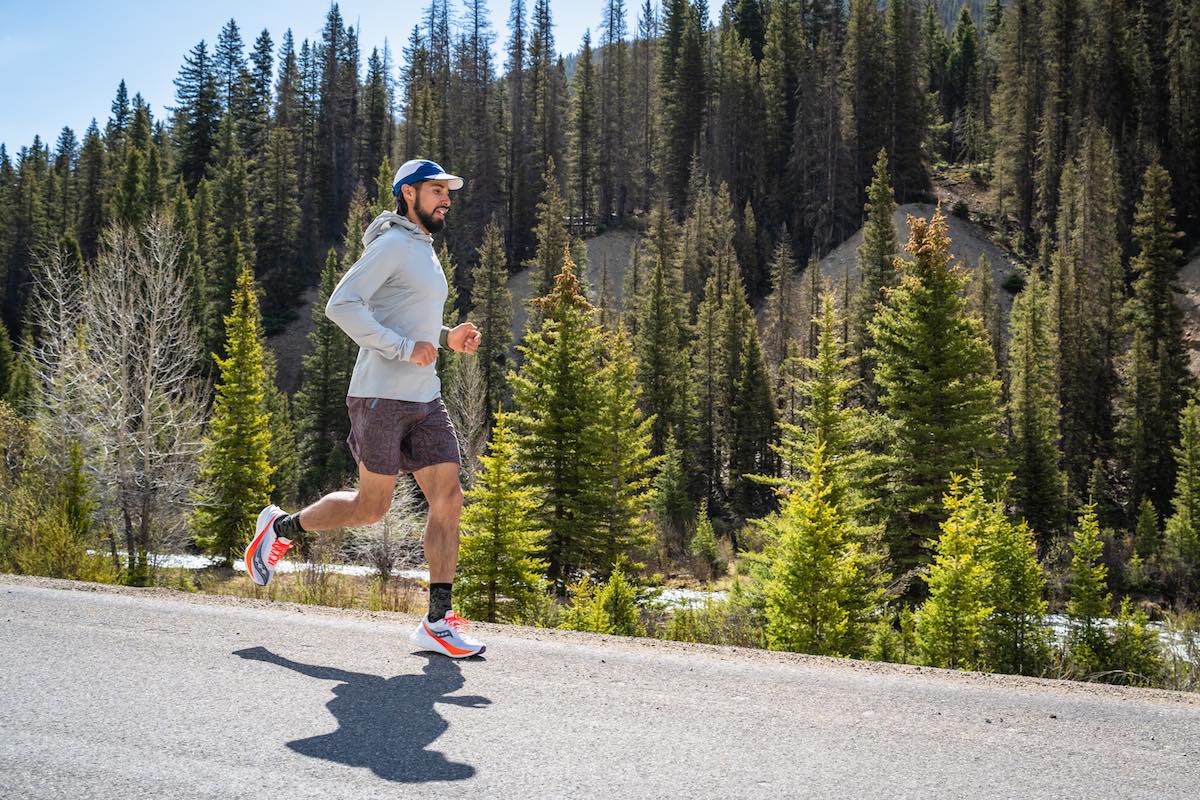
Running in the Saucony Endorphin Pro 4. Photo: iRunFar/Eszter Horanyi
Cushion
There was a time when if you wanted maximum cushion, you’d have to run in a heavy or clunky shoe. Those days are mostly over, as shoe companies have created lightweight and responsive cushioning. For example, the lightest shoe on this list — the Saucony Endorphin Elite 2 — also has the highest stack height. The days of minimalist running shoes are mostly gone, and most shoes will have plenty of stack height and cushion.
Unless you’re seeking a minimalist shoe, the question is not whether you should get a cushioned shoe but how much cushion you should seek. The answer depends on your personal preference, running style, the frequency of your runs, and the surface on which you tread.
Generally speaking, we recommend at least moderate cushioning, especially if you’re running primarily on pavement. The Saucony Peregrine 15, a trail shoe, has the lowest stack height of all the shoes in this guide, with 28 millimeters at the heel and 24 millimeters at the toe.
The Saucony Triumph 23 is a great everyday trainer with a high stack height of 37 and 27 millimeters at the heel and toe, respectively. The 10-millimeter drop is pretty aggressive, and some might prefer the 6-millimeter drop and high level of cushioning of the Saucony Guide 18 instead.
Support
Most shoes provide a neutral level of support that works for most runners.
Some people have ankles that pronate or fall inward too much, called overpronation, and could benefit from a stability shoe that guides their foot into a more neutral position. The easiest way to determine if you are an overpronator is to go to a running specialty store, hop on their treadmill, and have an employee watch your stride.
What’s overpronation? Let’s start with pronation, which is the natural inward collapse of the foot’s arch as it absorbs and distributes impact while running or walking. Everyone pronates. Underpronation — also called supination — is when the arch barely collapses and is generally associated with high arches. Those who supinate or have a normal range of pronation are good with neutral shoes.
However, if you overpronate, meaning your arch collapses past the typical range of pronation, you might consider stability running shoes. Generally, those with flat arches are more likely to need stability shoes. Again, it’s tough to tell on your own if you exceed the typical range of pronation, so having a running specialty store employee take a look isn’t a bad idea.
Stability shoes provide more support with a wider midfoot or overall platform, higher side walls, additional foam, or a rocker profile to help guide the foot into a more neutral stride. The Saucony Guide 18 has an asymmetrical design intended to keep your foot and ankle in alignment. You can check out more options in our Best Stability Shoes guide.
Fit
Correct fit is one of the most important aspects of picking a running shoe. Having the wrong fit of running shoe can lead to a few problems, from not being able to lock down your foot for the most efficient stride to blisters and hot spots from running. For the most part, Saucony’s running shoes fit true to size. Saucony also offers wide versions in a few of its models. If you’ve been running a long time, your typical shoe size will work for Saucony. If you’re new to running, you might consider checking out a specialty running store, where they’ll measure your foot to ensure you’re getting the correct shoe size. Generally speaking, you’ll want about a thumb’s width of space from the end of your toe to the front of the shoe.
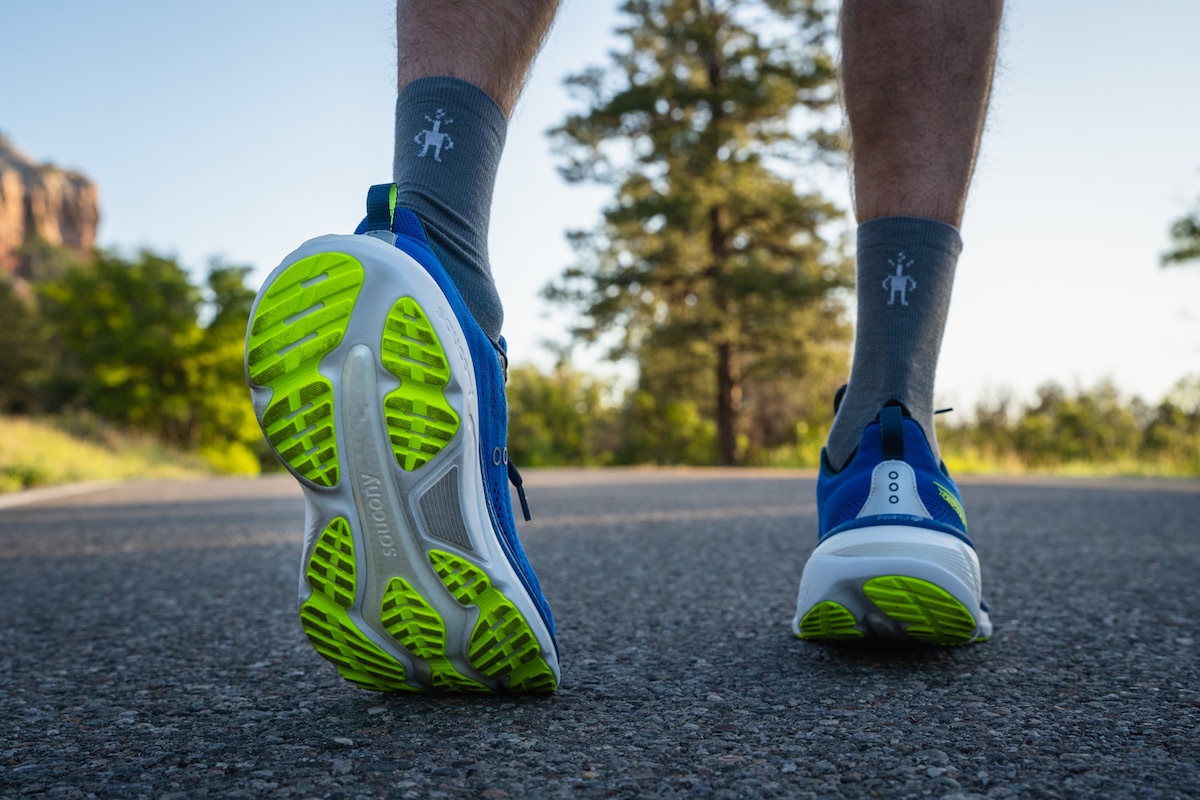
The Saucony Hurricane 25 is one of Saucony’s most maximum cushioned running shoe. Photo: iRunFar/Eszter Horanyi
Why You Should Trust Us
iRunFar’s team of testers has decades of experience running. Nathan Allen, the writer of this guide, has run in Saucony’s since high school cross country and track in the early 2000s. He still considers the Peregrines one of the best trail running shoes on the market. To create this guide, we researched Saucony’s most popular and highest-performing trail and road running shoes. We narrowed them down to about a dozen and distributed them to our testers across the country. iRunFar requires at least 100 miles run on a pair of shoes before deciding to include them in a buyer’s guide or not. We put hundreds of miles on most of the shoes in this guide.
For this guide, our testers were based across the American West in Colorado, Oregon, and California. We covered many types of terrain, including trails, pavement, and gravel roads. This guide has been around long enough that we’ve logged shoes year-round in multiple climates and conditions. We picked shoes based on a few factors, including fit, feel, comfort, performance, and durability. We tried to include shoes that are versatile and will work for many different types of runners.
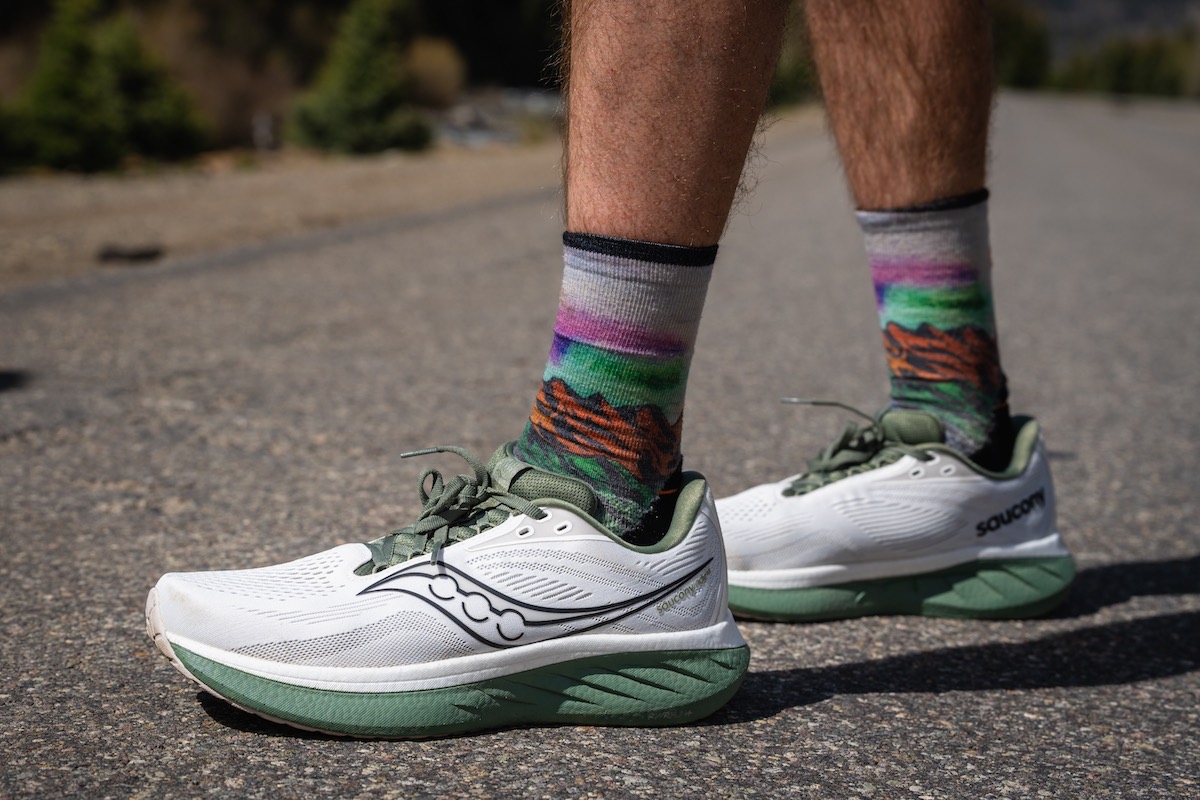
The Saucony Ride 18 is a solid neutral daily trainer. We didn’t pick it for this guide because we like the versatility of the Endorphin Speed 5. Photo: iRunFar/Eszter Horanyi
Frequently Asked Questions About Saucony Running Shoes
What are the best Saucony running shoes?
We believe the shoes listed above are currently the best Saucony shoes available. Most of them will work for a wide range of people. That said, running shoes are deeply personal, so what works for us might not work for you.
Over the years, we’ve run in nearly every model of Saucony running shoe available. We’ve found that the Saucony Endorphin Speed 5 is a highly versatile road running shoe, while the Saucony Peregrine 15 excels on trails.
Are Saucony shoes better than those from other shoe brands?
Again, running shoes are deeply personal, and what works for someone might not work for another. Saucony is recognized as a reliable generalist brand that consistently produces shoes that fit and work well for a wide range of people.
In addition to standard running shoe sizes, Saucony offers many of its shoes in wide versions, which typically indicates that the brand wants to meet the needs of most runners. When it comes to super shoes, we believe the Saucony Endorphin Elite 2 competes with the best in the market.
What makes Saucony shoes great?
Saucony is an excellent generalist shoe brand that meets the needs of most runners. They offer shoes that are relatively affordable and widely available online and in brick-and-mortar running stores.
Our testers have loved the Saucony Peregrine 15 and previous versions of the shoe for a long time, and the middle-of-the-road drop of the Saucony Endorphin Speed 5 makes it accessible to many different types of runners.
What’s the difference between a racing shoe and a non-racing shoe?
Generally speaking, the major difference between racing shoes and non-racing shoes lies in the materials and technology used. Racing shoes will have the brand’s best upper materials, which are breathable, lightweight, and comfortable. It’ll also have the brand’s highest-quality midsole foams. As mentioned above in the proprietary midsole foams and technology section, the highest-quality midsole foams will also be the lightest, most responsive, and efficient. This often makes racing shoes more expensive than daily trainers, which is also a difference between the shoes. Racing shoes will also be lighter, bouncier, more efficient, and faster.
Do I need racing shoes?
We don’t recommend investing in top-end racing shoes unless you will use them and you’re really trying to run a fast time. Most runners can get by with daily trainers. But if you are trying to qualify for a competitive ultra or trail race, or trying to qualify for a top road marathon like Boston, then it’s definitely worth it to purchase racing shoes. We also recommend doing at least a few speed workouts and uptempo, or race miles, in the shoes you plan on racing in so you can fully break them in and get a feel for the shoes.
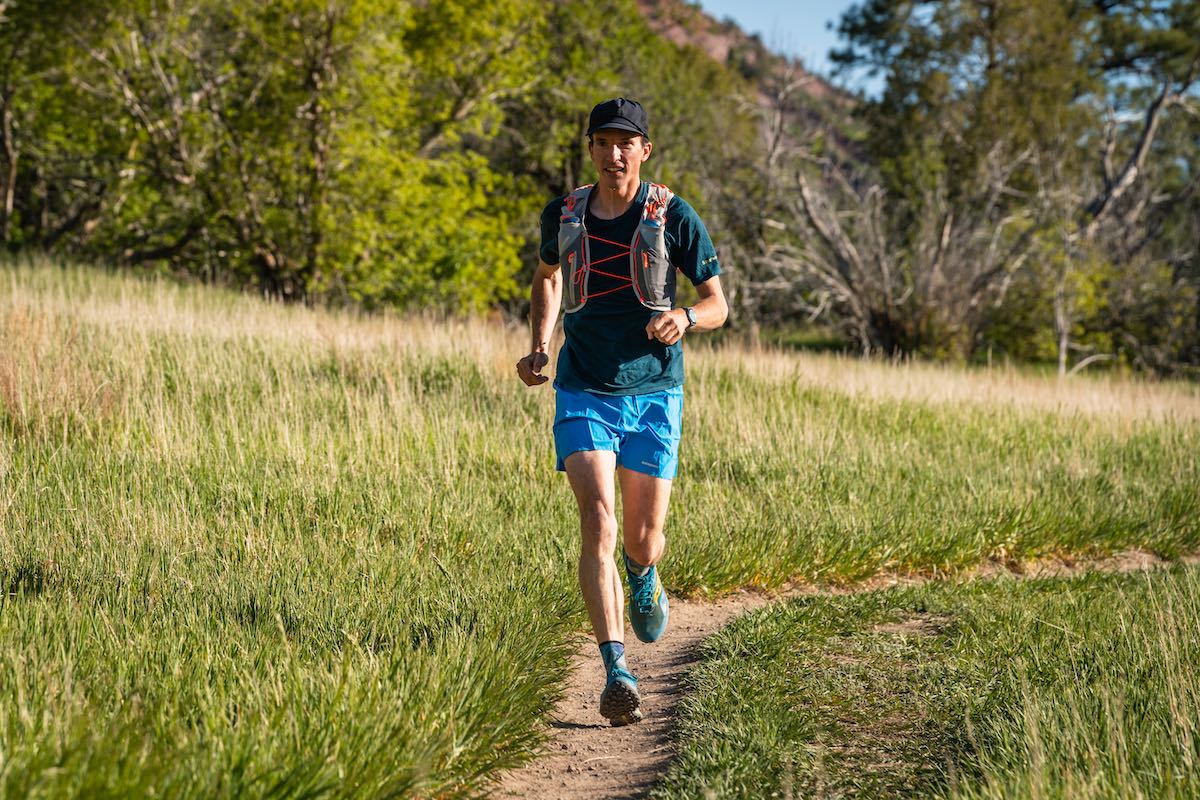
The Saucony Peregrine line has shoes that have been iRunFar favorites for many years. Photo: iRunFar/Eszter Horanyi
Call for Comments
- Do you have any experience with the Saucony running shoes in this guide?
- What is your most important element in a great pair of running shoes?
- Tell us about your favorite pair we might have missed so we can test them.
